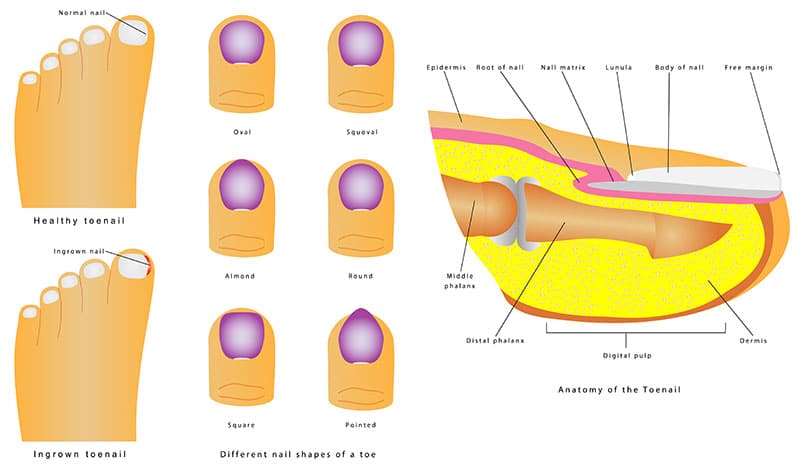Ingrown Toenails, Causes and Symptoms

Ingrown toenails are also known as Onychocryptosis is a very common form of nail disease. It is actually painful as the nail penetrates or cuts into both the sides of the nail bed or paronychium. The nail enters the nail bed but an ingrown toenail will be overgrown toe skin. The initial condition begins with a microbial inflammation of the paronychium which is secondary to a granuloma and results in the buried nail inside the granuloma. Ingrown nails can occur anywhere in the nails of both the hands and feet, but is commonly found in toenails. Onychocryptosis or an ingrown toenail is caused by the prevention of the flesh by the silver of a nail.
If this condition is left untreated for a long time, ingrown toenails can progress into an abscess or an infection which requires surgical treatment. The condition is very common among adolescents and adults but occurs very rarely in infants and children. Men have a greater chance of getting affected by Onychocryptosis than women. People in their early ages, especially in their 20s and 30s, gets affected by this condition. Any nail can be ingrown but the condition is found mostly in the big toe. Contact us today if you with questions or concerns.
Causes:
• If the trimming of the toenails is not done properly, it can cause the nails to dig into the skin. The trimming should be done straight across and not rounded.
• High heels or tight-fitting shoes will cause the toes to get compressed together and would pressure the nail to grow abnormally.
• Fungal infection is a kind of disorder which would cause widened or thickened toenail to develop.
• Any situation which causes the nail to get damaged repeatedly or an acute injury causes an ingrown toenail.
• You are more likely to develop an ingrown toenail if one or more members of your family have this condition. Some people have their nails rounded than others normally or may be the underlying bone can be more upturned which usually increases the chance of developing Onychocryptosis.
Symptoms:
• The toe end becomes reddened and painful with swelling. No pus or drainage is formed.
• Tissue and extra skin will grow around the nail and a yellowish drainage will begin. This is how the body reacts to the trauma of an irritating skin around the nail.
• There is a chance for an infection to develop which would cause a white colored drainage or pus in the area.
Treatment and home remedies:
• Around 4 times, soak your foot in warm water without adding soap, salts or any antibacterial agents.
• Keep the foot clean after washing it twice a day including the affected area.
• Avoid tight fitting shoes and heels. Wear sandals if possible.
• Ibuprofen and acetaminophen are the painkillers which can be taken if the pain is unbearable. Visit a doctor if there is no improvement in the next four days.
The doctors usually prefer splint which protects the skin from the sharp corner of the toenail. If any extra tissue has grown up around the affected area, the doctors will remove that tissue to help it heal faster.








